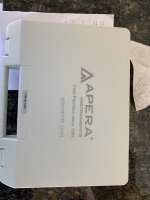- Jul 18, 2018
- 189
- Pool Size
- 23000
- Surface
- Vinyl
- Chlorine
- Salt Water Generator
- SWG Type
- Hayward Aqua Rite (T-15)
I bought an Apera PH 60 to test the PH of my pool water. Supposed to be accurate to the hundredths. I am not sure why I bought it as I have been successful managing my pool water with the Taylor surecheck (the small comparator). I think I just wanted a new toy!
Now that I have used it, however, the readings from the Apera are a bit lower than that of the Taylor. The Apera runs about .27 lower than the Taylor consistently. Yesterday the Apera showed a PH of 7.53 and the Taylor about 7.8. After adding 16 oz muriatic acid, the Apera showed 7.24 and the Taylor about 7.5.
Just curious. Which is more accurate?
Now that I have used it, however, the readings from the Apera are a bit lower than that of the Taylor. The Apera runs about .27 lower than the Taylor consistently. Yesterday the Apera showed a PH of 7.53 and the Taylor about 7.8. After adding 16 oz muriatic acid, the Apera showed 7.24 and the Taylor about 7.5.
Just curious. Which is more accurate?


